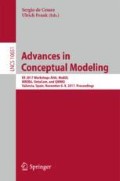Abstract
Goal refinement is a crucial step in goal-oriented requirements analysis to create a goal model of high quality. Poor goal refinement leads to missing requirements and eliciting incorrect requirements as well as less comprehensiveness of produced goal models. This paper proposes a technique to automate detecting bad smells of goal refinement, symptoms of poor goal refinement. Based on the classification of poor refinement, we defined four types of bad smells of goal refinement and developed two types of measures to detect them: measures on the graph structure of a goal model and semantic similarity of goal descriptions. We have implemented a support tool to detect bad smells and assessed its usefulness by an experiment.
Access this chapter
Tax calculation will be finalised at checkout
Purchases are for personal use only
References
Ali, R., Dalpiaz, F., Giorgini, P.: A goal-based framework for contextual requirements modeling and analysis. Requir. Eng. 15(4), 439–458 (2010)
Espada, P., Goulão, M., Araújo, J.: A framework to evaluate complexity and completeness of KAOS goal models. In: Salinesi, C., Norrie, M.C., Pastor, Ó. (eds.) CAiSE 2013. LNCS, vol. 7908, pp. 562–577. Springer, Heidelberg (2013). https://doi.org/10.1007/978-3-642-38709-8_36
Fillmore, C.J.: Lexical entries for verbs. Found. Lang. 4, 373–393 (1968)
Giorgini, P., Mylopoulos, J., Nicchiarelli, E., Sebastiani, R.: Reasoning with goal models. In: Spaccapietra, S., March, S.T., Kambayashi, Y. (eds.) ER 2002. LNCS, vol. 2503, pp. 167–181. Springer, Heidelberg (2002). https://doi.org/10.1007/3-540-45816-6_22
Gralha, C., Araújo, J., Goulão, M.: Metrics for measuring complexity and completeness for social goal models. Inf. Syst. 53, 346–362 (2015)
Hayashi, S., Tanabe, D., Kaiya, H., Saeki, M.: Impact analysis on an attributed goal graph. IEICE Trans. Inf. Syst. E95–D(4), 1012–1020 (2012)
Kaiya, H., Horai, H., Saeki, M.: AGORA: attributed goal-oriented requirements analysis method. In: Proceedings of the RE, pp. 13–22 (2002)
Kaiya, H., Saeki, M.: Ontology based requirements analysis: lightweight semantic processing approach. In: Proceedings of the QSIC, pp. 223–230 (2005)
van Lamsweerde, A.: Requirements Engineering: From System Goals to UML Models to Software Specifications. Wiley, Hoboken (2009)
Mendonça, D., Ali, R., Rodrigues, G.N.: Modelling and analysing contextual failures for dependability requirements. In: Proceedings of the SEAMS, pp. 55–64 (2014)
Nakamura, R., Negishi, Y., Hayashi, S., Saeki, M.: Terminology matching of requirements specification documents and regulations for compliance checking. In: Proceedings of the RELAW, pp. 10–18 (2015)
Negishi, Y., Hayashi, S., Saeki, M.: Supporting goal modeling for eliciting regulatory compliant requirements. In: Proceedings of the CBI, pp. 434–443 (2017)
Ohnishi, A.: Software requirements specification database based on requirements frame model. In: Proceedings of the ICRE, pp. 221–228 (1996)
Rolland, C., Proix, C.: A natural language approach for Requirements Engineering. In: Loucopoulos, P. (ed.) CAiSE 1992. LNCS, vol. 593, pp. 257–277. Springer, Heidelberg (1992). https://doi.org/10.1007/BFb0035136
Saeki, M., Hayashi, S., Kaiya, H.: A tool for attributed goal-oriented requirements analysis. In: Proceedings of the ASE, pp. 670–672 (2009)
Saeki, M., Kaiya, H.: Supporting the elicitation of requirements compliant with regulations. In: Bellahsène, Z., Léonard, M. (eds.) CAiSE 2008. LNCS, vol. 5074, pp. 228–242. Springer, Heidelberg (2008). https://doi.org/10.1007/978-3-540-69534-9_18
Shao, K.T.: Tree balance. Syst. Biol. 39(3), 266–276 (1990)
Silva, L., Moreira, A., Araújo, J., Gralha, C., Goulão, M., Amaral, V.: Exploring views for goal-oriented requirements comprehension. In: Comyn-Wattiau, I., Tanaka, K., Song, I.-Y., Yamamoto, S., Saeki, M. (eds.) ER 2016. LNCS, vol. 9974, pp. 149–163. Springer, Cham (2016). https://doi.org/10.1007/978-3-319-46397-1_12
Tanabe, D., Uno, K., Akemine, K., Yoshikawa, T., Kaiya, H., Saeki, M.: Supporting requirements change management in goal oriented analysis. In: Proceedings of RE, pp. 3–12 (2008)
Wu, Z., Palmer, M.: Verbs semantics and lexical selection. In: Proceedings of ACL, pp. 133–138 (1994)
Yang, H., De Roeck, A.N., Gervasi, V., Willis, A., Nuseibeh, B.: Extending nocuous ambiguity analysis for anaphora in natural language requirements. In: Proceedings of the RE, pp. 25–34 (2010)
Yang, H., Willis, A., De Roeck, A.N., Nuseibeh, B.: Automatic detection of nocuous coordination ambiguities in natural language requirements. In: Proceedings of the ASE, pp. 53–62 (2010)
Yu, E.S.: Social modeling and i*. In: Borgida, A.T., Chaudhri, V.K., Giorgini, P., Yu, E.S. (eds.) Conceptual Modeling: Foundations and Applications. LNCS, vol. 5600, pp. 99–121. Springer, Heidelberg (2009). https://doi.org/10.1007/978-3-642-02463-4_7
Acknowledgments
This work was partly supported by JSPS Grants-in-Aid for Scientific Research Nos. JP15K00088, JP15K15970, and JP15H02685. We would like to thank Prof. Takako Nakatani for giving us sample goal models having poor refinement.
Author information
Authors and Affiliations
Corresponding author
Editor information
Editors and Affiliations
Rights and permissions
Copyright information
© 2017 Springer International Publishing AG
About this paper
Cite this paper
Asano, K., Hayashi, S., Saeki, M. (2017). Detecting Bad Smells of Refinement in Goal-Oriented Requirements Analysis. In: de Cesare, S., Frank, U. (eds) Advances in Conceptual Modeling. ER 2017. Lecture Notes in Computer Science(), vol 10651. Springer, Cham. https://doi.org/10.1007/978-3-319-70625-2_12
Download citation
DOI: https://doi.org/10.1007/978-3-319-70625-2_12
Published:
Publisher Name: Springer, Cham
Print ISBN: 978-3-319-70624-5
Online ISBN: 978-3-319-70625-2
eBook Packages: Computer ScienceComputer Science (R0)

